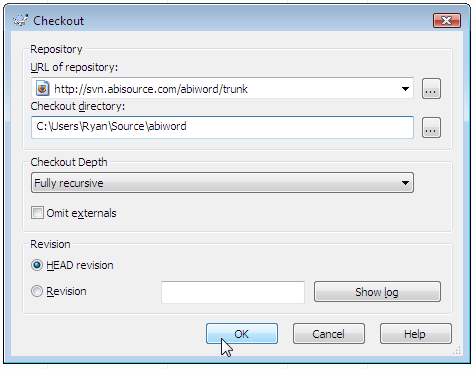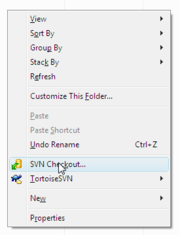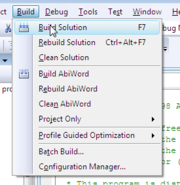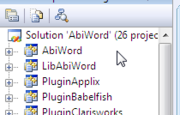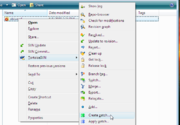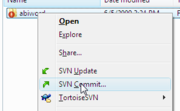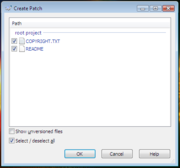Developing AbiWord on Windows using Visual C++
From AbiWiki
The Table of Contents, after the Introduction, is also the expert/short version of the instructions - the steps in each section often include screenshots and err on the side of verbosity, since the combination of tools (a Unix-like development style, Subversion version control with two modules, and Microsoft Windows and Visual Studio) might be new or unfamiliar to potential developers coming from either the "pure" Unix or the Windows development sides.
Contents
|
Introduction
MSVC is short for Microsoft Visual C++ 2008, an IDE for C++ development. You can use Microsoft Visual C++ 2008 Express Edition, a free-as-in-beer (but not free-as-in-speech) download, to build AbiWord on Microsoft Windows 2000 Professional*, XP, Server 2003, Vista, Server 2008*, or a Windows 7 pre-release (starred versions known to work by yours truly), or of course any non-Express version of Microsoft Visual Studio 2008 that includes Visual C++ and the ability to build native Win32 applications (AbiWord does not use .NET), such as Microsoft Visual Studio 2008 Professional.
Using MSVC is the quickest, easiest way to get started with AbiWord development on Windows and includes a number of useful tools, such as a debugger, an integrated development environment with editor, and more. There are alternatives, however, see below for details.
Windows Needed - Virtual Machines Work Great!
You do need a valid license for Windows in order to use MSVC and build AbiWord in this way. (It doesn't appear to work in Wine and we can't offer an opinion on the legal legitimacy of attempting to do so without a valid Windows license.) You can, however, run Windows in a virtual machine on Linux or Mac OS X, or even another version of Windows, of course subject to license agreements for your selected Windows OS. You can use the VM copy of Windows to install MSVC and build AbiWord, editing either in the VM or, with the source in a shared folder of some sort, in your preferred Windows, Linux or Mac OS X editor on the host system or a different VM, only using Windows and MSVC to build and run. Some limited free ways (specific sort of free/Free varies - read for yourself to ensure you are complying with the license) to run a licensed copy of Windows in a virtual machine include, in no specific order:
- VMware Server (VMware Server Wikipedia page)
- VMware Player (VMware Player Wikipedia page) using VMware Server or EasyVMX to create the virtual machine configuration initially
- VirtualBox (VirtualBox Wikipedia page)
- More virtual machine software:' Comparison of platform virtual machines on Wikipedia
- For what it's worth: Ryan has only used VMware Player/Server (using the older MinGW system) and the paid VMware Fusion product personally to build AbiWord, though he doubts there's any reasons these other systems would behave differently: pick one according to your needs and your license agreement desires.
- Help out: Improve this page by testing out other VM software and updating the section with notes on successful/unsuccessful tests, software versions tested, and date of test.
Why MSVC?
If building using non-Free Microsoft tools gives you moral qualms, you can also cross-compile for Windows using MinGW on a Linux platform (harder), or directly on Windows using MinGW (harder, slower, and more poorly documented).
- Help out: Improve this section by adding links to appropriate mailing list posts by Rob, cleardefinition.com (rp) pages for MinGW instructions, and/or create a new page to centralize/canonicalize MinGW instructions.
Space and Memory Requirements
Compiling software takes a lot of room, so (especially if you're creating a virtual machine and have to pick a virtual disk size) make sure you have plenty available. A minimum built source tree includes these components:
- The AbiWord source tree checked out from SVN, with the MSVC files checked out as well
- A single configuration of a completed build of the core AbiWord application in the tree
- The intermediate build files (object files, etc.) created by MSVC
This basic source directory, which doesn't include any plugins or any of the development tools themselves, takes around 700MB. If you want to build the plugins, too, your source tree will expand to about 1GB (compiling the entire solution including plugins). If you build a debug version and a "release" non-debug version, this space requirement will increase dramatically.
In general, you want probably at least 1.5GB free before starting basic AbiWord development (and more is better), just to play it safe in case MSVC requires more space free while building or to give your swap file room to expand. (Nevertheless, AbiWord takes only 20MB installed on its own - all that huge amount of extra space is only needed for development and building.)
If you're creating a virtual machine, choose a large disk size and "sparse" style (sometimes phrased more like "Do not allocate all space initially" or unchecking a checkbox stating the opposite) to set a maximum size disk that will nevertheless start small in actual disk space usage and expand up to the max as needed. You might also consider creating a second disk image exclusively for your source and build files, similarly large and sparse, since it's easier to expand that maximum size with VM software and Windows later on a non-system disk. If the option is provided, at least in VMware software, you want your source files on a disk image configured using the SCSI driver (on VMware Fusion: default for the system drive if installing Server 2008 or I believe when using "Easy Install" to install XP) since it introduces less overhead, and compiling is very disk-intensive.
As always, more RAM memory is better: you want at least 1GB RAM allocated to a Windows 2000 Professional virtual machine, or more if you're using a newer Windows version that isn't so frugal with memory, if you can spare it.
- For what it's worth: Ryan hasn't tested to see what the minimum is for a build, but suspects that if you go much below 1GB, especially if 512MB or below, you'll have a fairly sluggish experience. He uses 1GB assigned to a Win2k virtual machine (only tested using MinGW on 2.6.x/pre-new-buildsystem trunk and earlier), and 1.5GB assigned to a Server 2008 virtual machine, and it works well.
- Help out: Improve this section by testing out memory requirements and updating this paragraph.
Get the Tools
TortoiseSVN for Version Control
Visit the TortoiseSVN project page to download and install TortoiseSVN, a Subversion version control client for Windows that includes integration into Windows Explorer (the file manager). It will suggest you reboot after installing - while the Explorer integration seems to work right away on Windows 2000, it does appear to actually need that reboot on Vista/2008.
- Help out: Improve this section by figuring out this reboot thing, or removing any reference to not rebooting and just mandate a reboot.
Microsoft Visual C++ 2008 (Express)
Visual C++ 2008 Express is a free (as in beer) development environment and compiler from Microsoft: Visual C++ 2008 Express Edition Download and install it. You might also need to install the Platform SDK, potentially. (Ryan used the Professional Edition, not the Express Edition.)
Of course, if you have some other version of Visual Studio 2008 that includes Visual C++ and support for building native Win32 applications, you can use that and skip installing the Express Edition.
- Help out: Improve this section by testing to see if you need to separately install the Platform SDK for 2008 like you needed to with earlier Express Editions.
Optional: MSDN Library (Express)
If you'd like to have local reference material on C++ and Win32 programming integrated into the IDE, you can also install the MSDN Library (either the slimmed-down Express edition or the huge full version - both are available for free). You don't need to do this, though: you can access this material online in a web browser as well, at the MSDN Online Library, or, at least for the non-Win32 bits, using your favorite search engine to find other resources.
7-Zip (to open .tar.gz files)
Available at the 7-Zip Download Page (you probably want the "exe, 32-bit, 7-Zip" unless you know otherwise), this is a free, open source zip utility for Windows (like WinZip but free and open source, rather than paid/shareware) that supports Unix-type compressed file formats. You only really need this if you are installing from a downloaded tarball rather than version control, but it's good to have anyway. You might want to associate it (using the preferences dialog in the 7-Zip File Manager) with all filetypes it supports except zip and cab, which are supported natively by Windows, for maximum ease of use. Even if you don't associate it with any filetypes, you can always get to it using right-click in Windows Explorer (the standard file browser).
Create a Source Folder
- First, make a folder to store source code in: if you're using Windows Vista/2008, it's fine to put it in your profile folder like
c:\Users\Yourname\source\
or, on any version of Windows (2000 Pro, XP, or Server 2003),
c:\src\
is also a fine idea for a source folder.
- In case you ever want to build using the MinGW tools, or build other OSS software that might use those tools, try to keep it in a folder with no spaces in the path.
- AbiWord will be in a self-contained subfolder in whichever folder you create, so you can name it generically and put source for other great open source software in it, too!
- Go into that new folder using the file browser (Windows Explorer), then pick a path in the next major section based on your preference.
Get the Source - Pick a Method
Using Version Control
This is the recommended way, and lets you keep up to date with the latest development code. These instructions show how to perform an anonymous checkout (if you don't have a commit account, like if you're just starting developing) of the "trunk" developer mainline - if you have an account, or if you want a different development branch, change the SVN checkouts accordingly, and you're on your own (especially if you pick a different branch).
- Help out: Improve this section by adding instructions for installing necessary Pageant/Putty SSH pieces and SSH keys, and performing checkouts (and commits) using a "commit" (blueant) account.
If you're starting from scratch, make sure to follow both the Check Out AbiWord Trunk and Check Out msvc2008 Solution Files Nested In abiword steps in this section, skipping the update section. If you already performed a source code checkout according to those steps, skip those steps and follow only the Update an Existing Checkout section.
Check Out AbiWord Trunk
- Right click in your "source" directory, and choose SVN Checkout. (Don't see it? Make sure you installed TortoiseSVN and its Explorer Integration, which is a default option, then rebooted!) Enter the SVN path
http://svn.abisource.com/abiword/trunk/
(This is where you'd change the path if you have a commit account, or if you want to use another branch, though the MSVC stuff only works with the trunk branch as of June 2009.)
- On the checkout directory, add "\abiword" to the end of the path shown (which should be where you are), so you get a path like:
c:\Users\Yourname\source\abiword
or
c:\src\abiword
- If you wanted, you could add "abiword-trunk" or some other designation instead of just "abiword", if you're like Ryan and build all sorts of different branches. Be careful to modify the directions appropriately, in that case.
- Click OK, leaving all other options at their default setting. Let the checkout complete, this might take a little while.
Check Out msvc2008 Solution Files Nested In abiword
- Go into the abiword directory you just created with your checkout. You should see a number of folders and files.
- Right-click in a blank area (not on a folder or file!) and choose SVN Checkout again.
- This time, you want to enter the SVN URL (again, this is where you change if you have an account or a different branch)
http://svn.abisource.com/abiword-msvc2008/trunk/
- On the checkout directory, it should show your current location, which also should be the path you entered in the previous step. You want this module to be checked out "underneath" the abiword checkout: add "\msvc2008" on the end, so it looks like (for example, modify as appropriate)
c:\Users\Yourname\source\abiword\msvc2008
or
c:\src\abiword\msvc2008
- Click OK, leaving all other options at their default setting. Let the checkout complete - this one should be reasonably quick, but not instantaneous.
- Proceed directly to the Opening and Building step - when you come back and want to get new updates to the source, you'll need to only follow the Update an Existing Checkout subsection of "Get the Source" - you do not need to do a fresh checkout again!
Update An Existing Checkout
If you've already checked out the source, but want to update, you'll need to do it in two steps. Make sure that you have closed Visual C++, just to be safe.
- First, go into your source folder (the parent to the abiword folder), right click on the abiword folder created by your checkout, and choose "SVN Update." Let it complete, this will take a little bit.
- Then, go into the abiword folder, find that msvc2008 folder, right-click it, and choose "SVN Update." This will update the MSVC project files, and will take a little bit. (You closed MSVC, right?)
If there are conflicts in either step, be sure to resolve them before moving on - that means that someone committed a change to a file you also modified but didn't commit your changes to. When you've resolved a conflict (in a text editor or MSVC), right click that file, choose TortoiseSVN, and choose Resolved. If the upstream change is simply that the developers committed a patch you submitted, you can right-click that file with the conflict, choose TortoiseSVN, and choose Revert. This will eliminate all your changes to that file and replace it with a fresh copy from the server, so if this isn't what you want, resolve the conflict manually!
From a Source Tarball (Release) - Incomplete
Note: Ryan is not sure if release tarballs as of 2.7.2 includes the msvc2008 files somewhere. (You might need to grab the abiword-msvc2008 SVN module at the desired release tag, based on the instructions above, in addition to your main tarball.)
Basic idea of the process: You'll want to put the downloaded tarball in the source folder you created, right click it, and choose 7-Zip, Extract Here if you don't already have a directory named abiword. (If you do, temporarily rename that directory, choose Extract Here on the tarball, then rename your new directory as desired and rename your old directory back to "abiword".)
- Help out: Improve this section by investigating to see if msvc2008 files are included in release tarballs, and whether or not it is, creating instructions here to build a specific release getting at least the core source tree from a tarball rather than SVN.
Opening and Building
Go into the msvc2008 folder
Remember, it's in your source\abiword\ folder, so you'll need to navigate to something like
c:\Users\Yourname\source\abiword\msvc2008
or
c:\src\abiword\msvc2008
if you've used the suggested paths so far.
Open the Solution File
Double-click the AbiWord.sln file. It should open Microsoft Visual C++ 2008 - if it doesn't (because you have another version of Visual Studio installed, or some other reason), open MSVC, choose File, Open, and navigate to the AbiWord.sln file from there.
Optional: Set the Startup Project
As of 5 June 2009, the startup project in the solution is the OpenDocument plugin, for some reason. (If that doesn't mean anything to you, just follow these steps the first time if you want to only build AbiWord and no import/export or tools plugins, and don't know your way around MSVC well.) This will probably end up getting fixed sooner or later, in which case following these steps and saving will have produced a conflict: in that case, don't be afraid to revert the solution file or project files in the msvc2008 folder, since that's not actually the source code, just configuration for MSVC. If you always want to build AbiWord and its plugins (the entire solution, not just the core AbiWord/libabiword project) or are comfortable just building a single project in the solution (click on it first and read the menu item to verify before building), you can skip these steps.
Right-click on AbiWord in the left "Solution Explorer" pane, and choose "Set as StartUp Project."
- Help out: Improve this section by removing it if this changes, or clarifying - is there any reason to set the startup project other than not having to click on AbiWord before building just the core project instead of the solution when you first open the solution?
Explore the code
Most of the actual AbiWord code is in the LibAbiWord project in MSVC, for technical reasons. You can edit it inside the development environment and do anything you'd normally do in MSVC.
- Help out: Improve this section by linking to a web resource providing a source overview (Doxygen, wiki, Developer web page, other?)
Build and Run AbiWord
Click on the Build menu, and choose Build Solution if you want to build AbiWord and all its plugins. To just build the core AbiWord, you'll want to build the AbiWord project in the Solution Explorer only. (Click on the AbiWord project, if you didn't set the startup project or have been poking around, then choose Build AbiWord from the menu.)
You can choose a build configuration (Debug or Release) from the toolbar drop-down, and use the "Play" (Start with Debugging) button (or F5) there to start your build of AbiWord in the debugger, which of course works best if you have chosen a debug build. This should work properly. You can also go to the Debug menu and choose Start Without Debugging (or Ctrl-F5) to just run AbiWord, no matter whether you chose a release or debug build.
When you do a build after your initial one, it should only build the files needed to include the changes (whether you made them or they came in from SVN), but you can (and should) clean the solution and build anew if you have a "weird" problem before reporting it as a bug.
If you have the appropriate dependencies installed (NSIS and a few plugins, most likely, though Ryan hasn't tested it yet), building the solution in a "Release" configuration will also produce the installer, all in a single step.
- 'Help out: Improve this section by adding NSIS instructions above and making this clearer.
Report Bugs
If you run across problems in your use of AbiWord or your reading through the code, don't hesitate to file a bug at the AbiWord Bugzilla! You need a free account, which just requires a name and an email address: use a free or "low-importance" email since spambots do browse our Bugzilla from time to time. (You might enjoy using SpamGourmet or Sneakemail for free redirector email addresses: make sure to add a filter to whitelist the Bugzilla software itself!) Learn more about bug reporting on the main AbiWord web site.
Submit Changes (creating patches, committing)
All bugs (whether filed by you or by others) are better with patches! If you've developed a fix or a feature in your checkout of AbiWord, create a patch to attach to the bug suing these steps.
The easiest thing to do to ensure you produce a clean patch file is to only make one logical modification (a single bug, etc.) at a time, so that you can include a patch file created based off of the entire abiword directory, rather than cherrypicking individual files. The instructions will work both ways, though.
Update your source tree
Immediately before starting the patch process, follow the steps in Update an Existing Checkout to make sure your patch applies cleanly to the latest development version. If you're committing directly, Subversion won't let you commit if you haven't updated to the latest revision of the source code. If you're making a patch, it's bad etiquette to provide a patch to a revision that's not the latest, unless for an important reason you have to provide a patch against (the latest!) source code release tarball. Carefully resolve any conflicts from the merge, and if there were conflicts, be observant and especially mindful of the files with resolved conflicts throughout the rest of the process.
Add new files, if applicable
If you've added any new files, right click them, choose TortoiseSVN, and choose Add.
- If you're creating a patch, rather than committing directly, you are able to skip the "Add" step, but it's not recommended in most cases: you'll need to be careful to have the "Show Unversioned Files" options set in all TortoiseSVN dialogs and double-check to ensure your new file is included in the patch.
- If you're adding a binary file and creating a patch, you will need to separately attach the new binary file to the bug report (with a note as to where it should be placed) since it will not be included in the patch - in this special case it might be best to skip the Add step since you won't put this file in the patch anyway.
You might also need to add them to the build environment (project/solution in MSVC, as well as auto* makefiles for other platforms), as appropriate. Adding files to the MSVC project/solution requires an additional patch procedure - keep an eye out for it below.
Find your modified files and clean up your changes
TortoiseSVN adds a "!" emblem on any file in the source that varies from the last update from SVN, as well as all parent folders of those files. When creating a patch, you'll want to only include those changes that are important - undoing any unimportant changes to whitespace and not including unrelated changes.
Go through, starting at the base abiword folder, and find each file marked as modified. You can do this either by just browsing through the directory, or by right-clicking the abiword directory, choosing TortoiseSVN, and choosing Check for Modifications to get a list of all files. (Ignore the note about msvc2008 being nested - you can uncheck "Show unversioned files" to hide this and any files that you haven't added to version control as explained above.)
For each modified file (not folder), right click, choose TortoiseSVN, and choose Diff to show a side-by-side view of the changes made.
- To revert a single line or multiple lines, such as an unneeded extra blank line, first select by clicking/clicking and dragging (respectively), then right-clicking the selection and choosing "Use other text block".
- To revert a whole block of a diff, right-click it (without first clicking to select) and choose "Use other text block".
- You can undo if you make a mistake, and you need to choose File, Save to save the modifications you've made.
- For more complex cleanups, open the source file in your desired editor (MSVC or another text editor) and make changes: you can save in that editor and choose "Reload" in TortoiseMerge (the diff window) to update the diff display.
- If you find that you don't need any of the changes to a file, you can either
- leave that file out from your final patch in a later step (if the changes are useful but just not in the context of this patch)
- or, revert the changes, permanently undoing them (if you don't need the changes ever again, for example, added printf statements or similar in other source files as learning aids). Changes can be reverted most easily with a right-click, TortoiseSVN, Revert.
Double-check the build
For safety's sake, in MSVC, choose Clean Solution, then choose Build Solution to build the application in its entirety, from scratch. Test the resulting application, making sure basic functions (especially any related to your patch) still work and that your patch does what it says it does. Be sure to mention any added bugs or side-effects when sharing the patch: depending on the importance of the patch's change, this will probably mean that modifications will be requested/made before committing the patch to the source tree.
It's important to test again after diff cleanup, even if you tested earlier, because there might have been unintended consequences to the cleanups you made.
If you are committing directly, unless you have a really good reason, do not commit changes that break other things without definite plans to fix those things, and preferably make any such changes in a separate SVN branch rather than the SVN trunk. Remember, if you break the build, you owe symbolic, metaphorical Internet donuts to the community!
Create the patch or commit your change
Once you have your source tree cleaned up and final changes tested, it's time to make the patch! Navigate to the parent of the abiword directory, probably
c:\Users\Yourname\source\
or
c:\src\
if you've been following these steps all along. You want to be able to see the parent directory ("abiword" in the most common case) of all the files in the SVN module.
Right-click on the abiword directory, choose TortoiseSVN, and choose Create Patch (or right-click, choose SVN Commit if you're committing a change directly using your commit account). You'll be shown a dialog with the names of changed files. If you created new files without adding them to the repository, in the case of a patch, make sure "Show Unversioned Files" is checked so you can see your extra file. Make sure the checkbox is checked only next those (and next to all those) files whose modifications you want to include in your patch/commit.
If you are creating a patch, click OK, and save the patch with a "good name" - no spaces (use - or _ instead), short filename, ends in .diff, includes a bug number if relevant, and includes a date (YYYYMMDD format at the beginning of the filename or right after the bug # is a good idea). Once it has been saved, open the patch in a text editor (notepad, notepad++, etc.) and look through it - does it include all the changes and only the changes that you wanted to include? Is it relatively easy to read and clear? Sometimes the diff algorithm makes some interesting choices, especially if you changed the order of similar code sections, but if there's anything that you can control that would improve the diff, make that change and create a new diff.
If you are committing, be sure to enter a good commit message before making the commit. A "good commit message":
- Has a short description as its first line, followed by a blank line (or is just a single line if it can be both brief and complete)
- Describes the changes and rationale, at a high level (be thorough but remember that this is a commit message, not source code comments)
- Mentions any bugs ("Fixes bug#999999") fixed by the included changes.
- Mentions any caveats of the changes, unintended side effects, etc.
- Includes the phrase "Please backport" if the change can safely be made to the stable series as well (generally only small bug fixes), and should be applied to the stable tree and included in the next stable release (don't do this yourself except as below)
- Does not otherwise mention "backport" unless:
- it is a bad idea to backport this change which otherwise might look safe to backport to a maintainer coping with developers not always labeling backportable commits (a bugfix that doesn't apply to stable, an apparently small feature that actually requires a large change)
- Commit message should include: "Do not backport - {reason}"
- this change should only be backported if another change is backported. Please consider why you are putting effectively a single change in two commits: unless there's a good reason (such as needed to change both the abiword and abiword-msvc2008 SVN modules), reconsider committing this particular patch. If you want to share partial progress on a large change, create a SVN branch for that change, which you can commit frequently to and merge back into trunk when complete.
- Commit message should include: "Backport only if r{SVN revision of other change} is backported" for a previous commit, or "Backport only if upcoming commit about {a short title for the future commit} is backported", for an upcoming commit, as appropriate.
- you have manually backported this change. (Don't do this without a very good reason! If a change is non-trivial to backport, you can do it but it's best to ask first. All initial changes should be made to a single-purpose branch of trunk or trunk itself unless the change only applies to the stable branch. If you need a trunk change backported before you can make a stable-only change, backport that change locally only (waiting to commit until the backport is made by the maintainer) and/or email the stable source tree maintainer to see if backports can be completed now before a release, currently Marc Maurer (uwog), with a reason and optionally a bribe for speedier service ;) )
- Commit message should include: "Do not backport - manually backported as r{SVN revision of commit to stable}" or "Do not backport - I will manually backport." as appropriate for the commit to trunk, and "Manual backport of r{SVN revision of commit to trunk}" or "Manual backport of my upcoming trunk commit" as appropriate for the commit to stable.
- If you must manually backport, it's best to first make the commit to trunk, then to stable.
- Manual backports must have this noted in both the trunk and stable commits, and a notification must be emailed to the developer email list and/or to Marc personally ("and" preferred) with both commit revision numbers so that the change merge system can be updated to reflect this.
- it is a bad idea to backport this change which otherwise might look safe to backport to a maintainer coping with developers not always labeling backportable commits (a bugfix that doesn't apply to stable, an apparently small feature that actually requires a large change)
- offers a brief acknowledgement to other developers who contributed substantially to the patch, debugging process, etc.
- Commit message should include: "Thanks to {name, optionally 'for help with ___'}+" - but don't go overboard: see next item.
- is concise, clear, and if necessary, followed by an email to the developer mailing list (ideally, subscribe to the svn commit mailing list and reply to the email with your commit) with any details that didn't fit in the commit message, aren't appropriate for inline documentation in the source, but are nonetheless important to mention to other developers and archive publicly with the mailing lists.
Important Note: If you make a change to the MSVC project or solution configuration (a build change, that is, something within the msvc2008 folder, not just edits to a source file from within the MSVC environment), you need to create a patch (potentially a second patch, if you made source changes as well) for the msvc2008 folder specifically instead of/in addition to a patch for the abiword folder - repeat this step except use the msvc2008 directory specifically instead of its parent, the abiword directory. You need to do this because the main AbiWord source and the msvc project files are two separate SVN modules, so they need to be handled separately.
Share your patch
If you committed directly to the source tree, congratulations, you're done! You'll want to update your checkout, just to be safe (and to make sure TortoiseSVN updates its emblems - in theory this step is unnecessary, but in practice it's a harmless and sometimes useful habit. Make sure to mark any bugs fixed by the commit as RESOLVED, noting in the comment the revision number and where it was committed and when it will be in a release version: for example, "Fix committed to the development tree, will be in 2.7.3 development alpha. Needs to be backported to be included in the next stable release, 2.6.9".
If you created a patch, the best thing to do is attach it to the bug it is associated with. Include any comments as to flaws in the patch, unintended side effects, etc, and any details that you think are important that aren't obvious from just looking at the diff. If there isn't a bug filed, search again to be sure (there are lots of bugs filed!), then file your own - yes, even for features (set the severity to "enhancement" and add the keyword "rfe"). Add the keyword "patch" to the bug once you've attached it, and if someone comments on the patch suggesting changes, etc, follow up and stay involved!
If for some reason you absolutely have to attach the patch to an email to the developer list, make sure that it is zipped (use 7-zip to "gzip" the diff, if you can, since .zip is not a common format for *nix developers to work with and .gz is much more common and traditional.) If you do not gzip it, your email will look fake and it will be discarded automatically by the spam filter without notifying you or the developers, so beware! Patches sent to the email list, however, tend to get lost, so make sure you have it on a bug.
